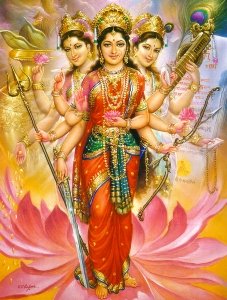Essence Of Devi Bhagavatha Purana |
|
 |
Ashtanga ( Eight Limbed) Yoga Practice Rules and Regulations Himavantha was bewildred to witness the Virat Rupa of Devi and when She ended that view and gone back to Her normal Self which by itself was fantastic, Himavantha emboldened himself as to how he could recall Her Physical Form from time to time. Maha Devi suggested that the only plausible way to retain Her image would be through Yoga Practice. |
The basic step in Yoga is to integrate the Jeevatma with Paramathma and win over the Arishat Varga or the Six enemies of lust, anger, greediness, infatuation, ego and envy. Then one follows ‘Yama’ ( the tenfold practice of ‘Ahimsa’or nonviolence, ‘Satyam’ or truthfulness, ‘asteyam’ or non-pilfering of mind and deed; ‘Brahmacharya’ or celibacy, ‘Mita Ahara’ or frugal eating, ‘Bahya anthara Suchi’ or external and internal cleanliness, ‘Naithikitha’ or morality, ‘Daya’ or mercy, ‘Kshamata’ or pardon and ‘Sthirata’ or stability), ‘Niyama’ ( the ten fold practice of ‘Tapasya’ or atonement, ‘Astikyatha’ or unflinching faith in God, Vedas, Devas and Virtue; ‘Santhushti’ or contentment, ‘Danaseelatha’ or charity for good causes,‘ Puja’ or worship of Almighty, ‘Siddhanta Acharana’ or practice of established precepts, ‘Hri’or refrain from evil acts, ‘Sraddha’ or fortitude in performing acts of faith, ‘Japam’ or repetitive and silent utterances of Manthras, Gayatri, and prayers; and ‘ Homams’ or daily oblations to Sacred Fire) and five ‘Asanas’ or postures viz. 1)‘Padmasana’ comprising of crossing the legs and drawing the feet of legs on the opposite thighs and simultaneously cathcing the toes of the right leg with the right hand right round the back and vice versa and sitting upright with ease ( Note: As this posture is practised only by expert Yogis, it would be sufficient to cross the hands on opposite thighs without streching the hands from the back); 2) ‘Swastikasan’ or place the soles of the feet completely under the thighs and sit erect; 3)‘Bhadrasan’ or placing the two heels on the two sides of the two nerves of the testicles near the anus and catching the two heels by the two hands at the lower parts of the testicles and sitting at ease. 4) ‘Vajra Asana’ or the Diamond posture consists of placing the feet on the two thighs and placing the fingers below the two thighs with hands and finally 5) ‘Virasan’ comprising sitting cross on the hams or hollow area behind the knee in placing the right foot under the right thigh and vice versa sitting straight and at ease. |
|
| Devi Bhagavata Purana Home | Next: Nadis and Chakras |
Back to the News Page